Comprehensive Analysis of Health Care Policy and Insurance Coverage
VerifiedAdded on 2022/10/31
|5
|1174
|75
Report
AI Summary
This report provides an analysis of health care policy, specifically focusing on the Affordable Care Act (ACA), Medicaid, and marketplace insurance. The document explores the complexities of health insurance, including premiums, coverage details, and the advantages and disadvantages of different insurance plans. It discusses shared benefits of Medicaid and marketplace insurance, such as access to preventive services. The report also highlights the disadvantages of marketplace insurance, such as copays, deductibles, and limitations on drug prescriptions. Furthermore, it examines the criticisms of both Medicaid and marketplace insurance, including out-of-pocket maximums and specialist service costs. The report also provides insights into the ACA open enrollment, short-term policies, and the resources available on the Kaiser Family Foundation website. References are included for further research.
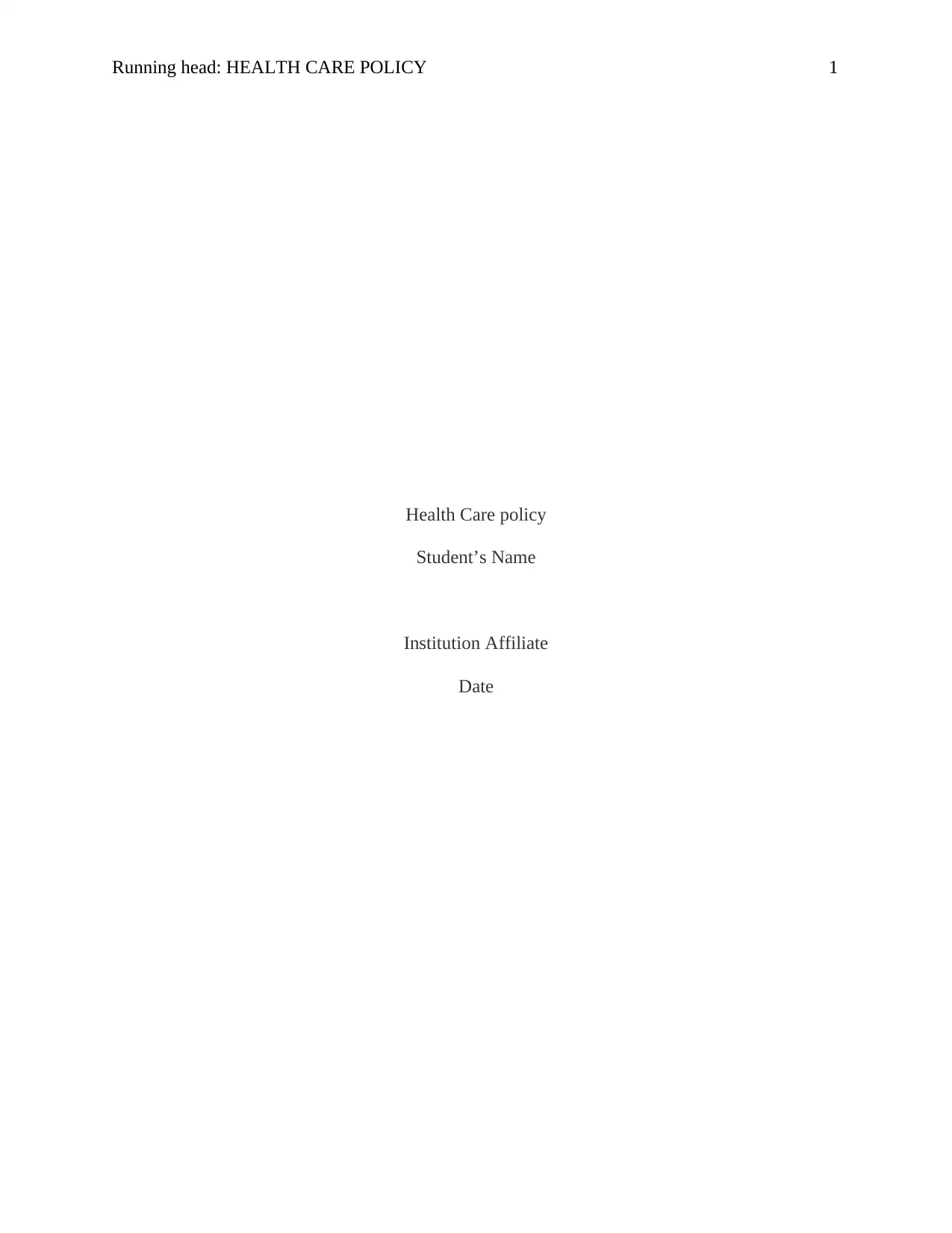
Running head: HEALTH CARE POLICY 1
Health Care policy
Student’s Name
Institution Affiliate
Date
Health Care policy
Student’s Name
Institution Affiliate
Date
Paraphrase This Document
Need a fresh take? Get an instant paraphrase of this document with our AI Paraphraser
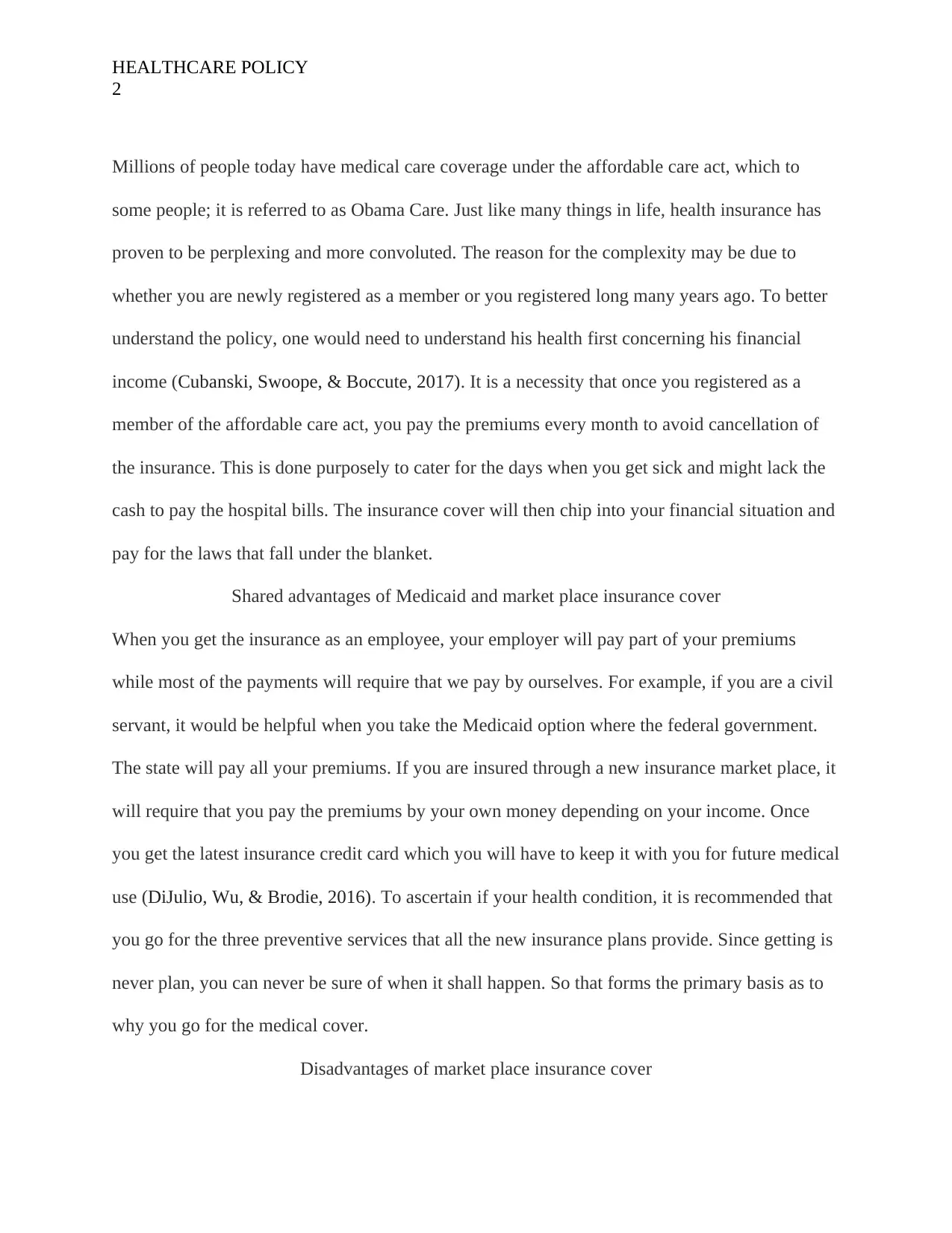
HEALTHCARE POLICY
2
Millions of people today have medical care coverage under the affordable care act, which to
some people; it is referred to as Obama Care. Just like many things in life, health insurance has
proven to be perplexing and more convoluted. The reason for the complexity may be due to
whether you are newly registered as a member or you registered long many years ago. To better
understand the policy, one would need to understand his health first concerning his financial
income (Cubanski, Swoope, & Boccute, 2017). It is a necessity that once you registered as a
member of the affordable care act, you pay the premiums every month to avoid cancellation of
the insurance. This is done purposely to cater for the days when you get sick and might lack the
cash to pay the hospital bills. The insurance cover will then chip into your financial situation and
pay for the laws that fall under the blanket.
Shared advantages of Medicaid and market place insurance cover
When you get the insurance as an employee, your employer will pay part of your premiums
while most of the payments will require that we pay by ourselves. For example, if you are a civil
servant, it would be helpful when you take the Medicaid option where the federal government.
The state will pay all your premiums. If you are insured through a new insurance market place, it
will require that you pay the premiums by your own money depending on your income. Once
you get the latest insurance credit card which you will have to keep it with you for future medical
use (DiJulio, Wu, & Brodie, 2016). To ascertain if your health condition, it is recommended that
you go for the three preventive services that all the new insurance plans provide. Since getting is
never plan, you can never be sure of when it shall happen. So that forms the primary basis as to
why you go for the medical cover.
Disadvantages of market place insurance cover
2
Millions of people today have medical care coverage under the affordable care act, which to
some people; it is referred to as Obama Care. Just like many things in life, health insurance has
proven to be perplexing and more convoluted. The reason for the complexity may be due to
whether you are newly registered as a member or you registered long many years ago. To better
understand the policy, one would need to understand his health first concerning his financial
income (Cubanski, Swoope, & Boccute, 2017). It is a necessity that once you registered as a
member of the affordable care act, you pay the premiums every month to avoid cancellation of
the insurance. This is done purposely to cater for the days when you get sick and might lack the
cash to pay the hospital bills. The insurance cover will then chip into your financial situation and
pay for the laws that fall under the blanket.
Shared advantages of Medicaid and market place insurance cover
When you get the insurance as an employee, your employer will pay part of your premiums
while most of the payments will require that we pay by ourselves. For example, if you are a civil
servant, it would be helpful when you take the Medicaid option where the federal government.
The state will pay all your premiums. If you are insured through a new insurance market place, it
will require that you pay the premiums by your own money depending on your income. Once
you get the latest insurance credit card which you will have to keep it with you for future medical
use (DiJulio, Wu, & Brodie, 2016). To ascertain if your health condition, it is recommended that
you go for the three preventive services that all the new insurance plans provide. Since getting is
never plan, you can never be sure of when it shall happen. So that forms the primary basis as to
why you go for the medical cover.
Disadvantages of market place insurance cover
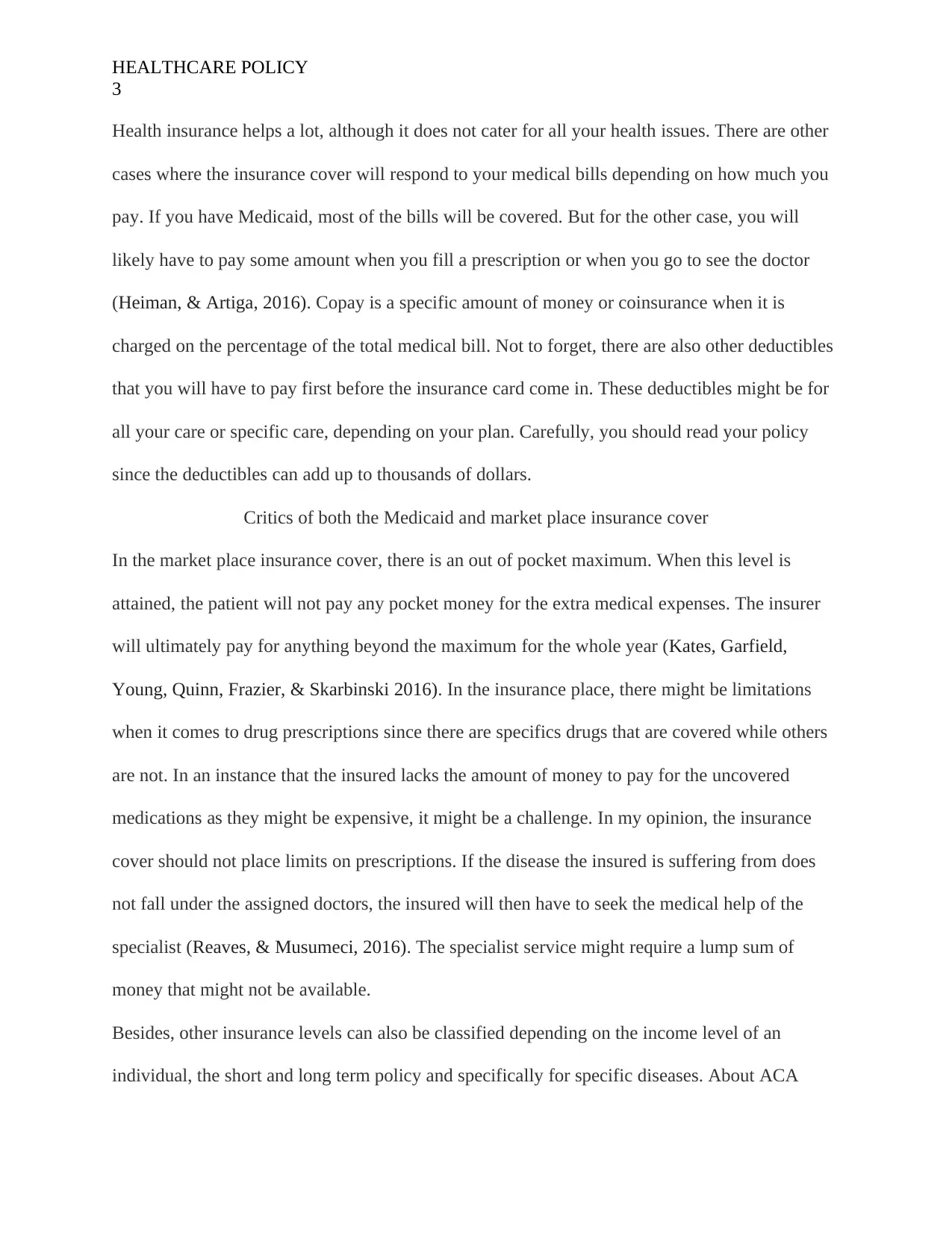
HEALTHCARE POLICY
3
Health insurance helps a lot, although it does not cater for all your health issues. There are other
cases where the insurance cover will respond to your medical bills depending on how much you
pay. If you have Medicaid, most of the bills will be covered. But for the other case, you will
likely have to pay some amount when you fill a prescription or when you go to see the doctor
(Heiman, & Artiga, 2016). Copay is a specific amount of money or coinsurance when it is
charged on the percentage of the total medical bill. Not to forget, there are also other deductibles
that you will have to pay first before the insurance card come in. These deductibles might be for
all your care or specific care, depending on your plan. Carefully, you should read your policy
since the deductibles can add up to thousands of dollars.
Critics of both the Medicaid and market place insurance cover
In the market place insurance cover, there is an out of pocket maximum. When this level is
attained, the patient will not pay any pocket money for the extra medical expenses. The insurer
will ultimately pay for anything beyond the maximum for the whole year (Kates, Garfield,
Young, Quinn, Frazier, & Skarbinski 2016). In the insurance place, there might be limitations
when it comes to drug prescriptions since there are specifics drugs that are covered while others
are not. In an instance that the insured lacks the amount of money to pay for the uncovered
medications as they might be expensive, it might be a challenge. In my opinion, the insurance
cover should not place limits on prescriptions. If the disease the insured is suffering from does
not fall under the assigned doctors, the insured will then have to seek the medical help of the
specialist (Reaves, & Musumeci, 2016). The specialist service might require a lump sum of
money that might not be available.
Besides, other insurance levels can also be classified depending on the income level of an
individual, the short and long term policy and specifically for specific diseases. About ACA
3
Health insurance helps a lot, although it does not cater for all your health issues. There are other
cases where the insurance cover will respond to your medical bills depending on how much you
pay. If you have Medicaid, most of the bills will be covered. But for the other case, you will
likely have to pay some amount when you fill a prescription or when you go to see the doctor
(Heiman, & Artiga, 2016). Copay is a specific amount of money or coinsurance when it is
charged on the percentage of the total medical bill. Not to forget, there are also other deductibles
that you will have to pay first before the insurance card come in. These deductibles might be for
all your care or specific care, depending on your plan. Carefully, you should read your policy
since the deductibles can add up to thousands of dollars.
Critics of both the Medicaid and market place insurance cover
In the market place insurance cover, there is an out of pocket maximum. When this level is
attained, the patient will not pay any pocket money for the extra medical expenses. The insurer
will ultimately pay for anything beyond the maximum for the whole year (Kates, Garfield,
Young, Quinn, Frazier, & Skarbinski 2016). In the insurance place, there might be limitations
when it comes to drug prescriptions since there are specifics drugs that are covered while others
are not. In an instance that the insured lacks the amount of money to pay for the uncovered
medications as they might be expensive, it might be a challenge. In my opinion, the insurance
cover should not place limits on prescriptions. If the disease the insured is suffering from does
not fall under the assigned doctors, the insured will then have to seek the medical help of the
specialist (Reaves, & Musumeci, 2016). The specialist service might require a lump sum of
money that might not be available.
Besides, other insurance levels can also be classified depending on the income level of an
individual, the short and long term policy and specifically for specific diseases. About ACA
⊘ This is a preview!⊘
Do you want full access?
Subscribe today to unlock all pages.

Trusted by 1+ million students worldwide
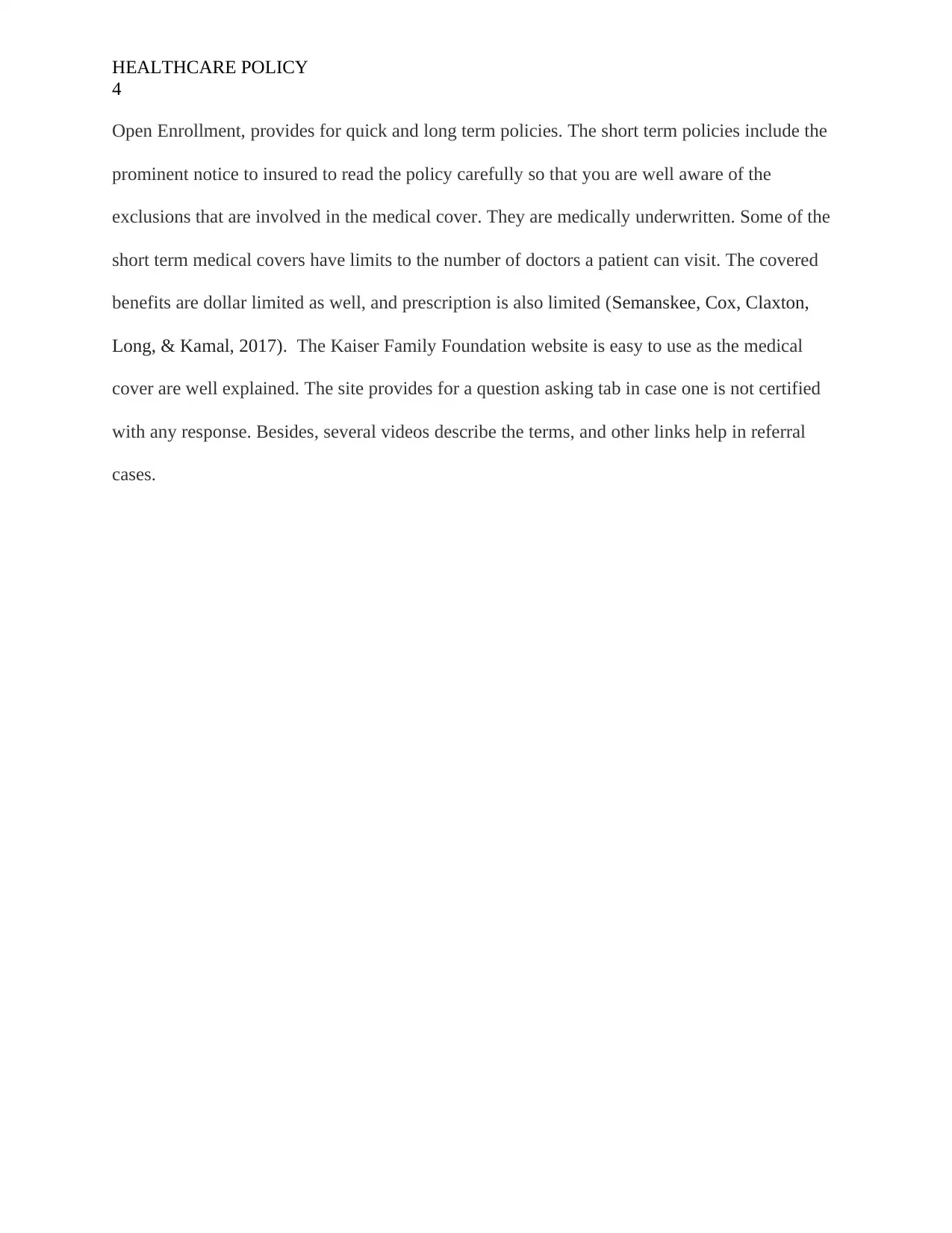
HEALTHCARE POLICY
4
Open Enrollment, provides for quick and long term policies. The short term policies include the
prominent notice to insured to read the policy carefully so that you are well aware of the
exclusions that are involved in the medical cover. They are medically underwritten. Some of the
short term medical covers have limits to the number of doctors a patient can visit. The covered
benefits are dollar limited as well, and prescription is also limited (Semanskee, Cox, Claxton,
Long, & Kamal, 2017). The Kaiser Family Foundation website is easy to use as the medical
cover are well explained. The site provides for a question asking tab in case one is not certified
with any response. Besides, several videos describe the terms, and other links help in referral
cases.
4
Open Enrollment, provides for quick and long term policies. The short term policies include the
prominent notice to insured to read the policy carefully so that you are well aware of the
exclusions that are involved in the medical cover. They are medically underwritten. Some of the
short term medical covers have limits to the number of doctors a patient can visit. The covered
benefits are dollar limited as well, and prescription is also limited (Semanskee, Cox, Claxton,
Long, & Kamal, 2017). The Kaiser Family Foundation website is easy to use as the medical
cover are well explained. The site provides for a question asking tab in case one is not certified
with any response. Besides, several videos describe the terms, and other links help in referral
cases.
Paraphrase This Document
Need a fresh take? Get an instant paraphrase of this document with our AI Paraphraser
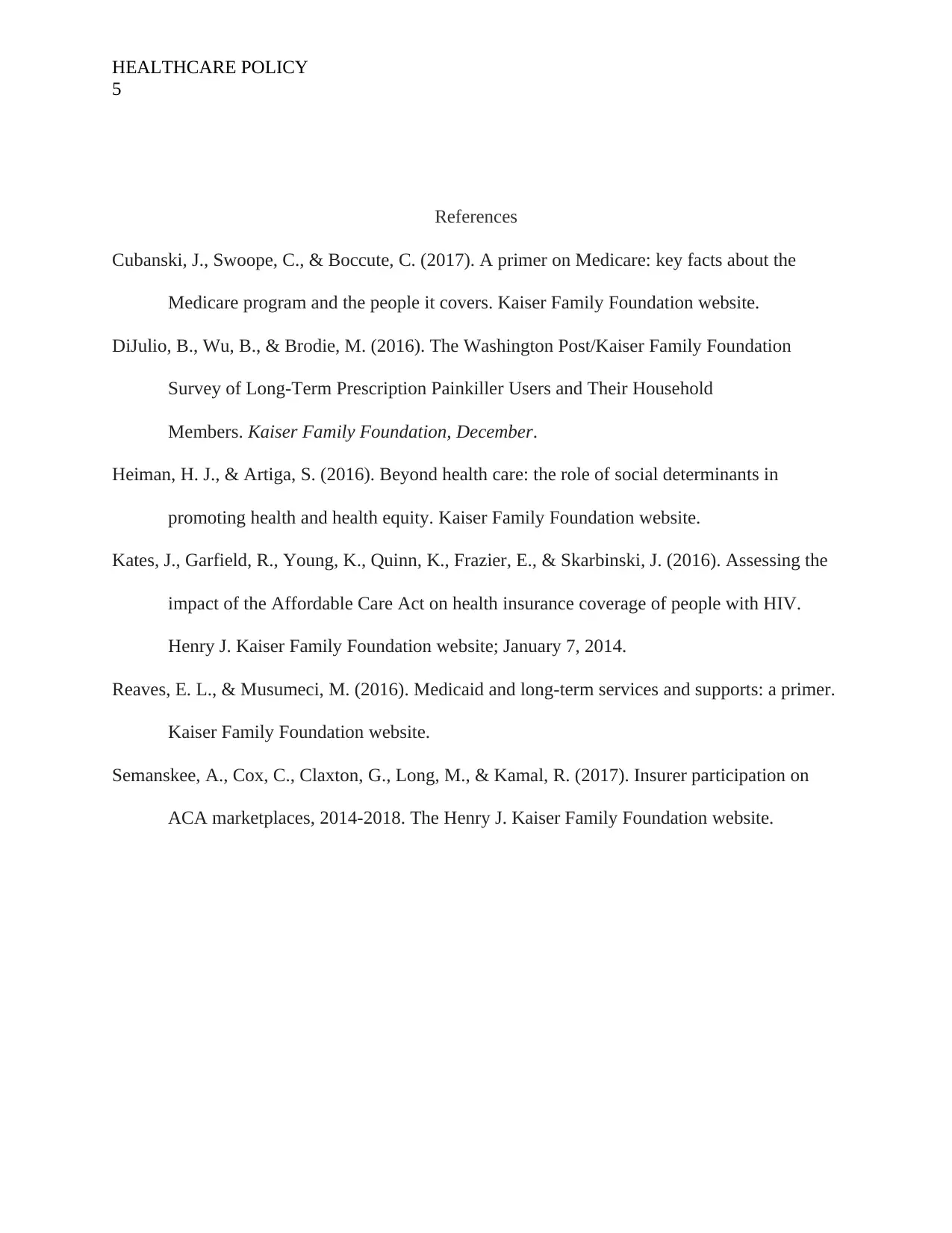
HEALTHCARE POLICY
5
References
Cubanski, J., Swoope, C., & Boccute, C. (2017). A primer on Medicare: key facts about the
Medicare program and the people it covers. Kaiser Family Foundation website.
DiJulio, B., Wu, B., & Brodie, M. (2016). The Washington Post/Kaiser Family Foundation
Survey of Long-Term Prescription Painkiller Users and Their Household
Members. Kaiser Family Foundation, December.
Heiman, H. J., & Artiga, S. (2016). Beyond health care: the role of social determinants in
promoting health and health equity. Kaiser Family Foundation website.
Kates, J., Garfield, R., Young, K., Quinn, K., Frazier, E., & Skarbinski, J. (2016). Assessing the
impact of the Affordable Care Act on health insurance coverage of people with HIV.
Henry J. Kaiser Family Foundation website; January 7, 2014.
Reaves, E. L., & Musumeci, M. (2016). Medicaid and long-term services and supports: a primer.
Kaiser Family Foundation website.
Semanskee, A., Cox, C., Claxton, G., Long, M., & Kamal, R. (2017). Insurer participation on
ACA marketplaces, 2014-2018. The Henry J. Kaiser Family Foundation website.
5
References
Cubanski, J., Swoope, C., & Boccute, C. (2017). A primer on Medicare: key facts about the
Medicare program and the people it covers. Kaiser Family Foundation website.
DiJulio, B., Wu, B., & Brodie, M. (2016). The Washington Post/Kaiser Family Foundation
Survey of Long-Term Prescription Painkiller Users and Their Household
Members. Kaiser Family Foundation, December.
Heiman, H. J., & Artiga, S. (2016). Beyond health care: the role of social determinants in
promoting health and health equity. Kaiser Family Foundation website.
Kates, J., Garfield, R., Young, K., Quinn, K., Frazier, E., & Skarbinski, J. (2016). Assessing the
impact of the Affordable Care Act on health insurance coverage of people with HIV.
Henry J. Kaiser Family Foundation website; January 7, 2014.
Reaves, E. L., & Musumeci, M. (2016). Medicaid and long-term services and supports: a primer.
Kaiser Family Foundation website.
Semanskee, A., Cox, C., Claxton, G., Long, M., & Kamal, R. (2017). Insurer participation on
ACA marketplaces, 2014-2018. The Henry J. Kaiser Family Foundation website.
1 out of 5
Related Documents
Your All-in-One AI-Powered Toolkit for Academic Success.
+13062052269
info@desklib.com
Available 24*7 on WhatsApp / Email
![[object Object]](/_next/static/media/star-bottom.7253800d.svg)
Unlock your academic potential
Copyright © 2020–2025 A2Z Services. All Rights Reserved. Developed and managed by ZUCOL.





